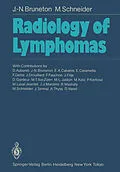Computerization of the radiological image (digitization, com puted tomography), the diagnostic contributions of ultra sonography, and the advent of magnetic resonance imaging all herald a new era in radiology. While this discipline retains its clinical nature, and continues to group together various specialities, the technical "common denominator" plays an increasingly important role, and requires a more global ap proach to the clinical problem. Centralization of state-of-the-art equipment in technical imaging centers - strategic points in future hospitals - will al low clinical radiologists to perform all of the examinations re quired for diagnosis and follow-up with a high degree of reli ability, under optimum security, and at the lowest possible cost. This is the right moment to publish this treatise, as we begin to apply this new approach to radiological studies. For purposes of clarity, the lymphomatous processes have been dealt with by anatomical location; more important, though, is the discussion of the multiple aspects of diagnosis, with particular emphasis on recent noninvasive modalities (characteristic visceral lesions ; analysis and characterization of the anatomical and tissue components of these lesions with the highest possible degree of precision; regional disease ex tension and anatomical features; information on concomitant regional involvement and distant sites), allowing selection of appropriate therapy and surveillance strategies.
Inhalt
1 Classification of Malignant Lymphomas.- 1.1 Hodgkin's Disease.- 1.2 Non-Hodgkin's Malignant Lymphomas.- 2 Lymphomas of the Central Nervous System.- 2.1 Intracranial Lymphomas.- 2.1.1 Tumoral Infiltration.- 2.1.1.1 Lymphomatous Meningitis.- 2.1.1.2 Dural Infiltration.- 2.1.1.3 Intracerebral Sites.- 2.1.2 Iatrogenic Lesions.- 2.1.2.1 Subacute Necrotizing Leukoencephalopathy.- 2.1.2.2 Other Leukoencephalopathies.- 2.1.2.3 Cerebral Atrophy.- 2.1.3 Intracranial Vascular Lesions.- 2.1.3.1 Arterial Thrombosis.- 2.1.3.2 Venous Thrombosis.- 2.1.3.3 Intracranial Hemorrhage.- 2.1.4 Infectious Complications.- 2.1.4.1 Bacterial Infections.- 2.1.4.2 Cerebromeningeal Tuberculosis.- 2.1.4.3 Cerebromeningeal Mycoses.- 2.1.4.4 Cerebromeningeal Viroses.- 2.1.4.5 Parasitoses.- 2.1.5 Protocol for Exploration by Imaging Modalities.- 2.2 Intraspinal Lymphoma.- 2.2.1 Tumoral Infiltration.- 2.2.1.1 Histopathologic Mechanisms.- 2.2.1.2 Clinical Picture and Radiological Exploration.- 2.2.2 Iatrogenic Pathologies.- 3 Orbital Lymphomas.- 3.1 Materials and Methods.- 3.2 Results and Discussion.- 3.3 Conclusion.- 4 Lymphomas of the Face and Neck.- 4.1 Waldeyer's Ring.- 4.2 Facial Structures.- 4.3 Thyroid Gland.- 4.4 Salivary Glands.- 4.5 Cervical Adenopathies.- 4.6 Larynx.- 4.7 Ear.- 5 Lymphomas of the Thorax.- 5.1 Hodgkin's Disease.- 5.1.1 Strategy.- 5.1.1.1 Radiological Examination.- 5.1.1.2 Computed Tomography.- 5.1.2 Mediastinum.- 5.1.2.1 Prognostic Value and Incidence.- 5.1.2.2 Radiological and CT Appearances.- 5.1.2.3 Recurrent Disease.- 5.1.2.4 Residual Mediastinal Masses.- 5.1.2.5 Nodal Calcification.- 5.1.2.6 The Irradiated Mediastinum.- 5.1.2.7 Heart.- 5.1.2.8 Esophagus.- 5.1.2.9 Great Vessels.- 5.1.2.10 Trachea and Bronchi.- 5.1.3 Lungs.- 5.1.3.1 Initial Manifestations.- 5.1.3.2 Recurrent Disease.- 5.1.4 Pleura, Chest Wall, and Diaphragm.- 5.1.4.1 Pleura and Chest Wall.- 5.1.4.2 Diaphragm.- 5.1.5 Childhood Hodgkin's Disease.- 5.2 Non-Hodgkin's Lymphomas.- 5.2.1 Strategy.- 5.2.2 Incidence.- 5.2.2.1 Anatomical Site.- 5.2.2.2 Histological Type.- 5.2.3 Primary Lymphoma of the Lung.- 6 Nodal Lymphomas of the Abdomen.- 6.1 Imaging Modalities.- 6.1.1 Lymphography.- 6.1.2 Ultrasonography.- 6.1.3 Computed Tomography.- 6.1.4 Radionuclide Studies.- 6.1.5 Interventional Imaging: Puncture Biopsy.- 6.2 Exploratory Strategy for Abdominal Lymph Nodes.- 6.2.1 Hodgkin's Disease.- 6.2.2 Non-Hodgkin's Lymphomas.- 7 Gastrointestinal Lymphomas.- 7.1 Malignant Lymphomas of the Gastrointestinal Tract.- 7.1.1 Non-Hodgkin's Lymphoma.- 7.1.1.1 Esophagus.- 7.1.1.2 Stomach.- 7.1.1.3 Small Bowel.- 7.1.1.4 Colon and Rectum.- 7.1.2 Hodgkin's Disease.- 7.1.2.1 Esophagus.- 7.1.2.2 Stomach.- 7.1.2.3 Small Bowel.- 7.1.2.4 Colon and Rectum.- 7.2 Malignant Lymphomas of the Spleen, Liver, Biliary Tract, and Pancreas.- 7.2.1 Spleen.- 7.2.2 Liver.- 7.2.3 Biliary Tract.- 7.2.4 Pancreas.- 8 Lymphomas of the Urinary Tract, the Male Genital System, and the Adrenal Glands.- 8.1 Urinary Tract.- 8.1.1 Kidney.- 8.1.1.1 General Characteristics.- 8.1.1.2 Radiological Exploration.- 8.1.1.3 Renal Complications.- 8.1.2 Ureter.- 8.1.2.1 General Characteristics.- 8.1.2.2 Radiological Exploration.- 8.1.3 Bladder.- 8.1.3.1 Primary Lymphoma.- 8.1.3.2 Secondary Lymphoma.- 8.2 Male Genital System.- 8.2.1 Prostate.- 8.2.2 Testis.- 8.3 Adrenal Glands.- 9 Gynecological Lymphomas.- 9.1 Breast.- 9.2 Ovary.- 9.3 Uterus.- 10 Lymphomas of Bone.- 10.1 Hodgkin's Disease.- 10.1.1 Mechanism of Appearance.- 10.1.2 Incidence.- 10.1.3 Clinical Features.- 10.1.4 Radiographic Appearance.- 10.1.4.1 Radiological Patterns.- 10.1.4.2 Anatomical Distribution of Radiological Features.- 10.1.5 Differential Diagnosis.- 10.1.6 Classification of Bone Involvement.- 10.2 Non-Hodgkin's Lymphoma.- 10.2.1 Mechanism of Appearance.- 10.2.2 Incidence.- 10.2.3 Radiological Features.- 10.2.4 Clinical Features.- 10.3 Burkitt's Lymphoma.- 10.4 Malignant Histiocytosis.- References.
